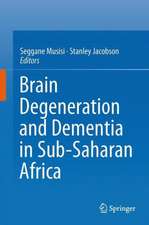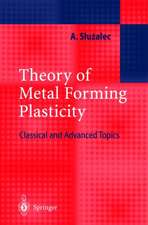Rodent Models of Stroke: Neuromethods, cartea 47
Editat de Ulrich Dirnaglen Limba Engleză Hardback – 8 iul 2010
| Toate formatele și edițiile | Preț | Express |
|---|---|---|
| Paperback (2) | 888.32 lei 43-57 zile | |
| Humana Press Inc. – 23 aug 2016 | 888.32 lei 43-57 zile | |
| Springer – 21 apr 2018 | 891.45 lei 43-57 zile | |
| Hardback (2) | 651.84 lei 43-57 zile | |
| Humana Press Inc. – 8 iul 2010 | 651.84 lei 43-57 zile | |
| Springer – 30 aug 2016 | 655.13 lei 43-57 zile |
Din seria Neuromethods
- 5%
 Preț: 347.57 lei
Preț: 347.57 lei - 15%
 Preț: 659.53 lei
Preț: 659.53 lei - 15%
 Preț: 665.08 lei
Preț: 665.08 lei - 18%
 Preț: 986.63 lei
Preț: 986.63 lei - 24%
 Preț: 852.89 lei
Preț: 852.89 lei - 18%
 Preț: 953.03 lei
Preț: 953.03 lei - 18%
 Preț: 955.25 lei
Preț: 955.25 lei - 20%
 Preț: 1129.36 lei
Preț: 1129.36 lei - 20%
 Preț: 1252.04 lei
Preț: 1252.04 lei - 18%
 Preț: 1291.45 lei
Preț: 1291.45 lei - 15%
 Preț: 652.31 lei
Preț: 652.31 lei - 18%
 Preț: 955.70 lei
Preț: 955.70 lei - 23%
 Preț: 705.39 lei
Preț: 705.39 lei - 18%
 Preț: 973.38 lei
Preț: 973.38 lei - 18%
 Preț: 964.86 lei
Preț: 964.86 lei - 18%
 Preț: 968.03 lei
Preț: 968.03 lei - 15%
 Preț: 662.95 lei
Preț: 662.95 lei - 15%
 Preț: 646.43 lei
Preț: 646.43 lei - 15%
 Preț: 649.71 lei
Preț: 649.71 lei -
 Preț: 395.29 lei
Preț: 395.29 lei - 19%
 Preț: 580.67 lei
Preț: 580.67 lei - 19%
 Preț: 584.12 lei
Preț: 584.12 lei - 19%
 Preț: 566.41 lei
Preț: 566.41 lei - 15%
 Preț: 652.17 lei
Preț: 652.17 lei - 15%
 Preț: 655.13 lei
Preț: 655.13 lei - 18%
 Preț: 959.36 lei
Preț: 959.36 lei - 15%
 Preț: 652.49 lei
Preț: 652.49 lei - 15%
 Preț: 649.54 lei
Preț: 649.54 lei - 15%
 Preț: 649.87 lei
Preț: 649.87 lei - 15%
 Preț: 650.19 lei
Preț: 650.19 lei - 15%
 Preț: 648.42 lei
Preț: 648.42 lei - 18%
 Preț: 1039.22 lei
Preț: 1039.22 lei - 18%
 Preț: 963.15 lei
Preț: 963.15 lei
Preț: 651.84 lei
Preț vechi: 766.87 lei
-15% Nou
Puncte Express: 978
Preț estimativ în valută:
124.73€ • 130.56$ • 103.81£
124.73€ • 130.56$ • 103.81£
Carte tipărită la comandă
Livrare economică 31 martie-14 aprilie
Preluare comenzi: 021 569.72.76
Specificații
ISBN-13: 9781607617495
ISBN-10: 1607617498
Pagini: 285
Ilustrații: XII, 286 p.
Dimensiuni: 178 x 254 x 25 mm
Greutate: 0.74 kg
Ediția:2010
Editura: Humana Press Inc.
Colecția Humana
Seria Neuromethods
Locul publicării:Totowa, NJ, United States
ISBN-10: 1607617498
Pagini: 285
Ilustrații: XII, 286 p.
Dimensiuni: 178 x 254 x 25 mm
Greutate: 0.74 kg
Ediția:2010
Editura: Humana Press Inc.
Colecția Humana
Seria Neuromethods
Locul publicării:Totowa, NJ, United States
Public țintă
Professional/practitionerCuprins
From Bedside to Bench: How Clinical Reality Should Instruct Stroke Modeling.- How to Avoid Bumping into the Translational Roadblock.- Modeling Focal Cerebral Ischemia in Rodents: Introduction and Overview.- Focal Cerebral Ischemia in the Mouse and Rat Using the Intraluminal Suture–Filament Model.- Focal Ischemia Models: Middle Cerebral Artery Occlusion Induced by Electrocoagulation, Occluding Devices, and Endothelin-1.- Rodent Models of Thromboembolic Stroke.- Photochemical and Endothelin Models of Focal Brain Ischemia.- Housing in an Enriched Environment: A Tool to Study Functional Recovery After Experimental Stroke.- Modeling Risk Factors and Confounding Effects in Stroke.- Effect of Anesthesia in Stroke Models.- Noninvasive Brain Imaging in Small Animal Stroke Models: MRI and PET.- Non-invasive Optical Imaging in Small Animal Models of Stroke.- Behavioral Testing in Mouse Models of Stroke.- Behavioral Testing in Rodent Models of Stroke.- Histology and Infarct Volume Determination.- Ethics of Modeling of Cerebral Ischemia in Small Animals.- Quality Control and Standard Operating Procedures.- Statistics in Experimental Stroke Research: From Sample Size Calculation to Data Description and Significance Testing.- Complexities, Confounders, and Challenges in Experimental Stroke Research: A Checklist for Researchers and Reviewers.
Recenzii
From the reviews:
“Rodent Models of Stroke by U. Dirnagl is simply the best ischemia book on principles, theory, protocols, and techniques which has been written over the past 25 years. … This book is aimed at a broad audience on ischemia research including graduate students, postgraduate scholars, junior faculty, and senior seasoned investigators. … In short, this is an ideal textbook for being a primer or a detailed reference to refer to. I highly recommend it.” (Joseph J. Grenier, Amazon.com, September, 2013)
“Rodent Models of Stroke by U. Dirnagl is simply the best ischemia book on principles, theory, protocols, and techniques which has been written over the past 25 years. … This book is aimed at a broad audience on ischemia research including graduate students, postgraduate scholars, junior faculty, and senior seasoned investigators. … In short, this is an ideal textbook for being a primer or a detailed reference to refer to. I highly recommend it.” (Joseph J. Grenier, Amazon.com, September, 2013)
Textul de pe ultima copertă
In view of the numerous failures of clinical trials aimed at improving stroke therapy, the role and potential benefit of experimentally modeling focal cerebral ischemia in rodents has been debated. When methods of systematic review and metaanalyis are applied, however, it turns out that experimental models actually faithfully predicted the negative outcomes of clinical trials. In addition, thrombolysis and neuroprotection by hypothermia, first described in animal models, are key examples of treatment modalities that have made it successfully into clinical practice. In Rodent Models of Stroke, an international consortium of authors aims at critically addressing the issues on a very practical level, from choosing the model and outcome measures, designing the experiment, conducting and analyzing it, to reporting it in a scientific publication. The structure and content of the book reflect both the authors’ longstanding expertise in experimental and clinical stroke research and their roles in training the scientific community in the tools of the trade. As a volume in the successful Neuromethods series, the chapters provide authoritative reviews of the most commonly used, well-honed approaches in the field today.Stimulating and easy-to-use, Rodent Models of Stroke will help its readers understand the limitations and the opportunities of modeling stroke in rodents and enable them to conduct experiments which will not only improve our understanding of the pathophysiology of this devastating disorder but also serve as the basis for developing new highly effective treatments.
Caracteristici
Provides hands-on guidance to most relevant stroke models in rodents Comprehensive guide to non-invasive imaging in rodent stroke research (MRI, optical, nuclear medicine) Covers all relevant techniques to document outcome, including the little documented topic of post-stroke behavioral analysis in the mouse Includes supplementary material: sn.pub/extras

















